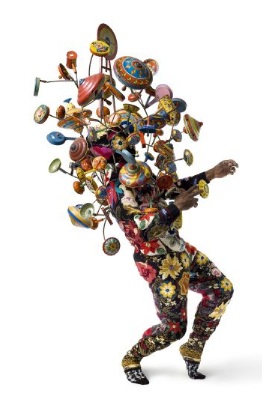

By Kim Voynar Voynar@moviecitynews.com
Going to the Center of the Earth
 I meant to write earlier about our trip to the Seattle Art Museum to see the Nick Cave: Meet Me at the Center of the Earth exhibit, but kept forgetting (this, among other things, is why I need a personal assistant).
I meant to write earlier about our trip to the Seattle Art Museum to see the Nick Cave: Meet Me at the Center of the Earth exhibit, but kept forgetting (this, among other things, is why I need a personal assistant).
I wanted to take a bunch of pics to show you, but unfortunately the entire exhibit was a “no photography” zone. I need to go back a couple more times to fully absorb what I saw and what it all means. But the Soundsuits, when you see all of them together, have a completely different feel than just seeing pictures of them.
The Soundsuits were the brainchild of Chicago artist Nick Cave, who is NOT, as I learned a while back, the Nick Cave you are thinking of. Evidently it’s not just me who was confused about that; they had a placard at the exhibit explaining the difference between this Nick Cave, who is a black artist from Chicago, and that Nick Cave, who’s a white Australian musician.
Anyhow …
When you’re face-to-face with these suits, you can’t help but start to marvel at the mind that conceived them. I was reading something at the exhibit about how the first Soundsuit Cave conceived and built was one of the twig suits, and it said something about one of the ideas for the suits being that they are a way to hide. There is no race or gender when the wearer is covered head to foot in one of Cave’s amazing creations.
Walking through the exhibit is a bit like stepping through the looking glass into a world of fantasy. There are tall, regal columns of colorful fake fur that immediately, for me, evoked Aunt Beast from Madeleine L’engel. Others made me think of Where the Wild Things Are. There are the twig suits, wild and primitive. There are suits made of various found materials — afghans, purses, sweaters, socks, whatever caught his eye and his fancy.
The suits are meticulously put together such that the designs flow organically. Metal apertures suspend a garden of metal flowers, a cacophy of noisemakers, ceramic birds, over suits comprised of colorful knits. One room houses suits comprised of thousands of seemingly identical white buttons sewn to the fabric shell. It’s all quite remarkable to look at.
Now, I’m hoping to catch a Soundsuit performance to see them in motion. If I manage that, I’ll let you know.














